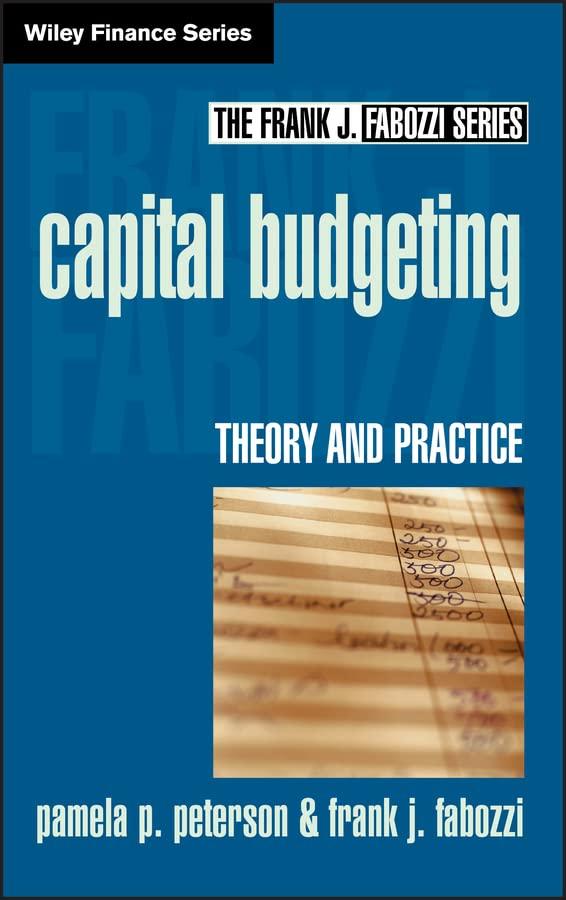Answered step by step
Verified Expert Solution
Question
1 Approved Answer
True or false Convertible bonds give bondholders an option to exchange each bond for a specified number of shares of common stock of the company.
True or false
- Convertible bonds give bondholders an option to exchange each bond for a specified number of shares of common stock of the company. While convertible bondholders may benefit if the stock price rises, it comes at a price as convertible bonds offer lower coupon rates than comparable, non-convertible bonds.
- The CAPM provides a prediction of the relationship that one should observe between the risk of an asset and its expected return. It provides evidence that risk and return are inversely related.
- Premium bond returns are a combination of below current market rate coupons and positive capital gains while discount bond returns are a combination of above market coupons and negative capital gains, essentially the reverse of the former. Discount bonds and premium bonds both mature at par.
- Price changes should be random and unpredictable and are the result of investors competing to discover relevant information on which to buy or sell securities before the rest of the market becomes aware of that information.
- The consumption based CAPM (Rubenstein, Lucas and Breeden) is a factor model in which the market portfolio excess return is replaced by a consumption-tracking portfolio. The Consumption CAPM is designed to accommodate investors who are concerned with time-varying, multi-period (i.e., lifetime) consumption.
- The CAPM assumes that investors are single period planners who agree on a common input list from security analysis and seek mean variance optimal portfolios. The CAPM assumes that security markets are ideal in the sense that they are large and investors are price takers, there are no taxes or transaction costs, all risky assets are publicly traded, and investors can borrow and lend any amount at a fixed risk-free rate.
- The APT (Ross) multifactor model uses a Morningstar-type construct while FF (French-Fama) uses one that is more macroeconomic. For example, APT uses a small minus big factor (capitalization) and a high minus low price-to-book factor while FF uses the growth rate in industrial production and unexpected inflation expectations, among others.
- Duration is a direct measure of the sensitivity of a bonds price to a change in its yield. Convexity equals the weighted average of the times to each coupon or principal payment. Duration, the second derivative of price with respect to a change in interest rates, specifically refers to the curvature of a bonds price-yield relationship.
- The EMH is the notion that stocks already reflect all available information. Market participants distinguish among three forms of the efficient market hypothesis. Each form has its own contentions, for example the semi-strong form asserts that all publicly available fundamental information is already reflected in prices as well as that from technical analysis (i.e., charts, graphs, etc.).
- The SML graphically portrays the expected return-beta relationship. Accordingly, at a beta equal to one, an investor can read off the vertical axis on the chart for the expected return on the market portfolio. Fairly priced assets plot exactly on the SML.
- The Disposition Effect relates to the tendency of investors to sell losers too soon and to hold onto winners too long. While a behavioral phenomenon, the disposition effect is irrational from many perspectives, including those from taxes, momentum, stop losses, etc.
- Holding maturity constant, a bonds duration is higher when the coupon rate is higher; generally decreases with its time to maturity; is lower when the bonds yield to maturity is higher; and equals its time to maturity when no coupon is paid (i.e., a zero coupon bond).
13. The prices of short-term bonds tend to be more sensitive to interest rate changes than the prices of long-term bonds. Coupons impact interest rate sensitivities.
- If an analyst expects interest rates to rise across the yield curve, the analyst would seek to have a longer-than-benchmark duration portfolio. If an analyst expects interest rates to decline across the yield curve, the analyst would seek to have a shorter-than-benchmark duration portfolio.
- As evidenced by recent market action (February-March 2020), one category of negative beta securities or assets is related to gold and technology stocks.
- Behavioral finance is the intersection of finance and psychology and focuses on systematic irrationalities that appear to oftentimes characterize investment decision-making. BF explores biases such as overconfidence, conservatism, and representativeness or heuristics such as mental accounting and loss aversion.
- If an analyst expects interest rates to rise across the yield curve, the analyst would seek to have a longer-than-benchmark duration portfolio. If an analyst expects interest rates to decline across the yield curve, the analyst would seek to have a shorter-than-benchmark duration portfolio.
- Growth oriented technical analysts oftentimes use price momentum and moving averages to uncover investable trends while those with value-oriented predispositions and processes may employ relative strength and sentiment in an attempt to discern potential future instances of reversions to the mean.
19. Prices of zero-coupon bonds rise over time, providing a rate of appreciation equal to the internal, compounded rate of return. Zero coupon bonds are also the vehicles of choice in constructing a yield curve and are oftentimes estimated, when a zero is not readily available, by a treasury strip.
Step by Step Solution
There are 3 Steps involved in it
Step: 1

Get Instant Access to Expert-Tailored Solutions
See step-by-step solutions with expert insights and AI powered tools for academic success
Step: 2

Step: 3

Ace Your Homework with AI
Get the answers you need in no time with our AI-driven, step-by-step assistance
Get Started


